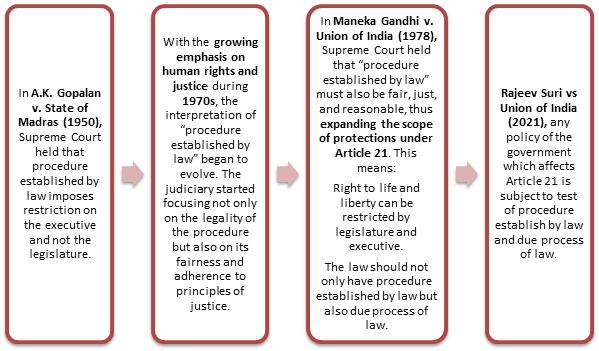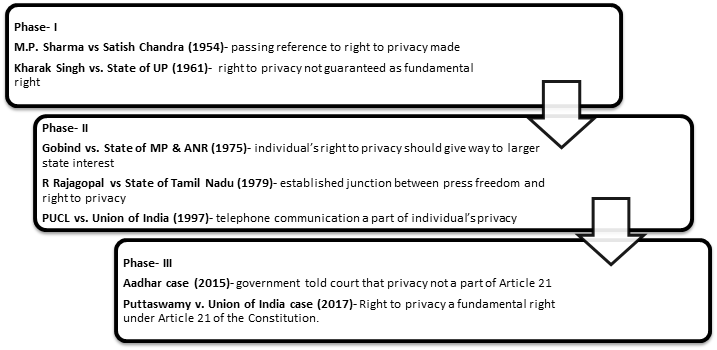“No person shall be deprived of his life or personal liberty except according to procedure established by law.”
Broadening scope of Article 21
-
- Francis Coralie Mullin v. Administrator, Union Territory of Delhi (1981)- Right to Dignity
- S. Puttaswamy v. Union of India (2017)- Right to Privacy
- Olga Tellis v. Bombay Municipal Corporation (1985)- Right to Livelihood
- Subhash Kumar v. State of Bihar (1991)- Right to a Clean and Healthy Environment
- State of Punjab v. Mohinder Singh Chawla (1997)- Right to Health
- Mohini Jain v. State of Karnataka (1992) and Unni Krishnan J.P. v. State of Andhra Pradesh (1993)- Right to Education
- Common Cause (A Regd. Society) v. Union of India (2018)- Right to Die with Dignity
- K. Basu v. State of West Bengal (1997)- Right Against Custodial Violence
- Chameli Singh v. State of Uttar Pradesh (1996)- Right to Shelter
- Navtej Singh Johar v. Union of India (2018)- Expanding Gender and Sexuality Rights
Evolution through case laws

Difference between ‘procedure established by law’ and ‘due process of law’
| Procedure established by law | Due process of law |
|---|---|
| • In this the court assess the procedure followed by the legislature to form a law and its implementation by executive. • It is explicitly mentioned under Article 21 of the Constitution. • It is borrowed from the Japanese Constitution. • It protects the individual only against the arbitrary action of the executive. | • In this the court would not only check the procedural validity but also check that whether it is just, fair and reasonable. • It is not explicitly mentioned anywhere in the Indian Constitution. • It borrowed from the American Constitution. • It protects the individual not only against the arbitrary action of the executive but also legislature. |
Right to privacy
It means right to be left alone especially in social affairs like family, marriage and procreation. It forms a fundamental aspect of individual dignity and autonomy.
Evolution of Right to privacy

Digital Personal Data Protection Act, 2023
| Applicability | To both online and offline collected data. |
| Consent | Except for ‘legitimate uses’ defined in the Bill. |
| Data Principal | The right to access processing information, request correction and erasure of data, nominate a representative in case of death or incapacity, and seek grievance redressal. |
| Data Fiduciaries | To ensure data accuracy, implement security safeguards, report breaches to the Data Protection Board of India and affected persons, and erase personal data when no longer needed. |
| Data Protection Board of India | • Monitoring compliance and imposing penalties. • Directing data fiduciaries to take necessary measures in the event of a data breach. • Hearing grievances made by affected persons. Appeals against the decisions of the Board will lie with TDSAT (Telecom Disputes Settlement and Appellate Tribunal). |
| Exemptions | Security of the state and public order, and research, archiving, or statistical purposes. |
Significance
-
- Protects the privacy of the individual (Article 21)
- Safeguards the legitimate aim of the state
- Promotes digital economy
- Independent authority to enforce the compliance.
- Follows the global minimum standard,matching with the international regime
Issues
-
- Curtails access to informationby diluting the RTI Act’s provisions by amending Section 8(1)(j) to exempt all personal information from disclosure.
- Srikrishna Committee (2018)– harm is a possible consequence of personal data processing.
- Not enough protection in case of cross-border transfer of data
- Fear of exclusionasonly 33% of women in India have ever used the Internet (NFHS).
- Independence of the Data Protection Board of India
Way forward:
-
- CJI DY Chandrachud- establish equilibrium between interests of individuals and valid apprehensions of the state.
- Robust digital governance, ensuringcomprehensive regulation
- BN Srikrishna committee-a careful balancing as neither the right to privacy not the right to information is absolute.
Euthanasia: The Right to die
About:
Euthanasia is the act of deliberately putting an end to someone’s life in order to eliminate pain or suffering. It is of two types:
-
- Active Euthanasia: An act of deliberately and actively doing something like injecting drug, to end a person’s life.
- Passive Euthanasia: Intentionally letting a patient die by withholding artificial life support such as ventilator or a feeding tube.
Case laws:
-
- Rathinam v. Union of India (1994)- “right to life” also includes the “right to die.”
- Aruna Ramchandra Shanbaug v. Union of India & Ors. (2011)- allowed passive euthanasia (withdrawal of life support) under strict guidelines.
- Common Cause v. Union of India & Ors. (2018)- Right to die with dignity as a fundamental right under Article 21.
- Common Cause v. Union of India & Ors. (2023)- simplified the process for making living wills and withdrawing life-sustaining treatment by removing bureaucratic hurdles.
Pros and cons of innovative interpretation of Article 21
| Pros | Cons | Way forward |
|---|---|---|
| • More rights accorded status of Fundamental rights. • It has resulted into policy interventions by the government. • Promotes socio-economic justice. • It has strengthened fundamental rights and has broadened their scope. | • Create obligation to enforce socio-economic rights, otherwise listed under DPSP. • Affects sanctity of fundamental rights as too many FRs. • Affects legitimacy of innovative interpretation when not fulfilled. • The unjusticiable rights started restricting justiciable rights. | • Innovative interpretation is required as Constitution is an organic document. • Judiciary should be more cautious while declaring new rights as fundamental rights. • Adherence to golden triangle i.e. Article 14, 19 and 21 should be the main focus. • Emphasis on constitutional morality. |

